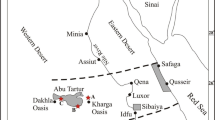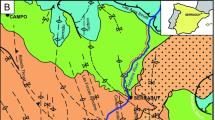Abstract
Cores of pelitic sediments (Eocene-Miocene) of the drillings Puchkirchen 1 and Geretsberg 1 (Molasse Basin, Upper Austria) have been studied to determine the mineralogical and chemical changes taking place during burial diagenesis. Mineralogical and chemical investigations of the bulk samples show that the deepest samples of the profiles are derived from a different source area. In particular, there is an increase in kaolinite and chlorite with depth and a decrease in quartz related to the initial sedimentology and provenance.
Investigations of the <2 µm and <0.2 µm fractions of the profiles Puchkirchen 1 and Geretsberg 1 reveal the diagenetic overprint of the mineral constituents: The gradual illitization of mixed-layer illite-smectite, also reflected in an increase of K2O and Al2O3, is displayed most prominently in the <0.2 µm fraction. The source for the Al and K is the dissolution of K-feldspar (<2 µm fraction), as indicated in many previous studies.
The I-S mixed-layer phases are randomly interlayered to a depth of 1600 m; from there on a regular interstratified I-S phase appears in coexistence with the randomly interlayered I-S mixed layer. The randomly oriented phase is still present in major amounts to depths of 2500 m, presumably as a result of the low geothermal gradient (2.9 °C/100 m) in the Molasse Basin.
The calculation of the structural formula of the end members illite and smectite from this series of I-S mixed-layer phases gave the following results: Smectite: \({K_{0.14}}{X^ + }_{0.44}\left( {A{l_{1.10}}M{g_{0.46}}F{e_{0.36}}T{i_{0.01}}} \right)S{i_{4.03}}{O_{10}}{\left( {OH} \right)_2}\) Illite: \({K_{0.44}}{X^ + }_{0.19}\left( {A{l_{1.26}}M{g_{0.42}}F{e_{0.38}}T{i_{0.01}}} \right)\left( {S{i_{3.52}}A{l_{0.48}}} \right){O_{10}}{\left( {OH} \right)_2}\)
The end-member interlayer charge for the smectite component (+0.58) is higher than reported for typical smectites (+0.32 to +0.47). It is suggested that the I-S phases of the Molasse Basin are probably intergrowths of 3 layer-silicate members: illite, low-charged smectite and high-charged smectite. The determined smectite end-member composition represents, therefore, an average for a variable 2-component smectite system. The charge-differences of the 2 smectites would likely reflect the differences in source material, which in turn would have led to the formation of different early, highly smectitic I-S phases in the sedimentary basin.
Similar content being viewed by others
References
APD 3. 5B. 1992. PC-APD 3. 5B, Philips PW 1877 Automated powder diffraction. Holland.
Association Nationale de la Recherche Technique. 1989. Geostandards newsletter 13 (Special Issue): 23.
Awwiller DN. 1993. Mite smectite formation and potassium mass transfer during burial diagenesis of mudrocks: A study from the Texas Gulf Coast Paleocene-Eocene. J Sed Pet 63:501–512.
Bruce CH. 1984. Smectite dehydration—Its relation to structural development and hydrocarbon accumulation in northern Gulf of Mexico Basin. AAPG Bull 68:673–683.
Burst JF. 1969. Diagenesis of Gulf Coast clayey sediments and its possible relation to petroleum migration. AAPG Bull 53:73–93.
Busenberg E, Clemency CV. 1973. Determination of the cation exchange capacity of clays and soils using an ammonia electrode. Clays Clay Miner 21:213–217.
Deer WA, Howie RA, Zussman J. 1962. Rock-forming minerals—Sheet silicates, vol. 3. Longmans.
Eberl DD. 1993. Three zones for illite formation during burial diagenesis and metamorphism. Clays Clay Miner 41:26–37.
Eberl DD, Środoń J, Mingchou L, Nadeau PH, Northrop HR. 1987. Sericite from the Silverton caldera, Colorado: Correlation among structure, composition, origin and particle thickness. Am Mineral 72:914–934.
Eberl DD, Środoń J, Northrup HR. 1986. Potassium fixation in smectite by wetting and drying. In: Davis JA, Hayes KF, editors. Geochemical processes at mineral surfaces. Am Chem Soc Symposium Series 323:296–326.
Glover ED. 1961. Method of solution of calcareous materials using the complexing agent, EDTA. J Sed Pet 31:622–626.
Horton RB, Johns WD, Kurzweil H. 1985. Hüte diagenesis in the Vienna Basin, Austria. TMPM 34:239–260.
Hower J, Eslinger EV, Hower ME, Perry EA. 1976. Mechanism of burial metamorphism of argillaceous sediment: 1. Mineralogical and chemical evidence. Geol Soc Am Bull 87:725–737.
Jasmund K, Lagaly G. 1993. Tonminerale und Tone. Darmstadt: Steinkopff. 490 p.
Johns WD, Kurzweil H. 1979. Quantitative estimation of il-lite-smectite mixed-phases formed during burial diagenesis. TMPM 26:203–215.
Köhler E, Wewer R. 1980. Gewinnung reiner Tonmineralkonzentrate für die mineralogische Analyse. Keramische Zeitschrift 32 Nr. 5:250–252.
Köster HM. 1979. Die chemische Silikatanalyse. Berlin: Springer-Verlag. 196 p.
Köster HM. 1981. The crystal structure of 2:1 layer silicates. In: Van Olphen H, Veniale F, editors. Developments in sed-imentology. Proc Int Clay Conf; 1981. Amsterdam: Elsevier. p 41–71.
Kunz B. 1978. Temperaturmessungen in Erdölbohrungen der Molassezone Oberösterreichs. Mitt ÖsterrGeol Ges 68:51–58.
Kurzweil H. 1973. Sedimentpetrologische Untersuchungen an den jungtertiären Tonmergelserien der Molassezone Oberösterreichs. TMPM 20:169–215.
Kurzweil H, Johns WD. 1981. Diagenesis of tertiary marl-stones in the Vienna Basin. TMPM 29:103–125.
Lagaly G, Weiss A. 1976. The layer charge of smectitic layer silicates. Proc Int Clay Conf; Mexico City; 1975. p 157–172.
Lynch, FL. 1997. Frio shale mineralogy and the stoichiometry of the smectite to illite reaction: The most important reaction in clastic sedimentary diagenesis. Clays Clay Miner 45:618–631.
Malzer O, Rögl F, Seifert P, Wagner L, Wessely G, Brix F. 1993. Die Molassezone und deren Untergrund. In: Brix F, Schultz O, editors. Erdöl und Erdgas in Österreich. Wien: NHM Wien, p 281–323.
Marshall CE. 1949. The structural interpretation of chemical analyses of the clay minerals. In: The colloid chemistry of the silicate minerals. New York: Academic Pr. 159 p.
Moore DM, Reynolds RC Jr. 1989. X-ray diffraction and the identification and analysis of clay minerals. New York: Oxford Univ Press. 332 p.
Perry EA, Hower J. 1972. Late-stage dehydration in deeply buried pelitic sediments. AAPG Bull 56:2013–2021.
Powers MC. 1967. Fluid-release mechanisms in compacting marine mudrocks and their importance in oil exploration. AAPG Bull 51:1240–1254.
Reynolds RC Jr. 1985. NEWMOD©, a computer program for the calculation of one-dimensional diffraction patterns of mixed-layered clays. R. C. Reynolds, Jr.: 8 Brook Drive, Hanover, NH.
Reynolds RC Jr. 1989. Principles and techniques of quantitative analysis of clay minerals by X-ray powder diffraction. In: Pevear DR, Mumpton FA, editors. Quantitative mineral analysis of clays, CMS Workshop Lectures, vol. 1. Boulder, CO: Clay Miner Soc. p 4–36.
Schultz LG. 1964. Quantitative interpretation of mineralogical composition from X-ray and chemical data for Pierre shale. Washington. US Geol Survey. Prof Paper 391-C.
Stul MS, Mortier WJ. 1974. The heterogeneity of the charge density in montmorillonites. Clays Clay Miner 22:391–396.
Sucha V, Kraus I, Geithofferova H, Petes J, Serekova M. 1993. Smectite to illite conversion in bentonites and shales of the East Slovak Basin. Clay Miner 28:243–253.
Sucha V, Siranova V. 1991. Ammonium and potassium fixation in smectite by wetting and drying. Clays Clay Miner 39:556–559.
Tollmann A. 1985. Die Molassezone. Geologie von Österreich. Band 2. Wien: Verlag Franz Deuticke. 710 p.
Yoder HS, Eugster HP. 1955. Synthetic and natural musco-vites. Geochim Cosmochim Acta 8:225–280.
Author information
Authors and Affiliations
Rights and permissions
About this article
Cite this article
Gier, S. Burial Diagenetic Processes and Clay Mineral Formation in the Molasse Zone of Upper Austria. Clays Clay Miner. 46, 658–669 (1998). https://doi.org/10.1346/CCMN.1998.0460606
Received:
Accepted:
Published:
Issue Date:
DOI: https://doi.org/10.1346/CCMN.1998.0460606




